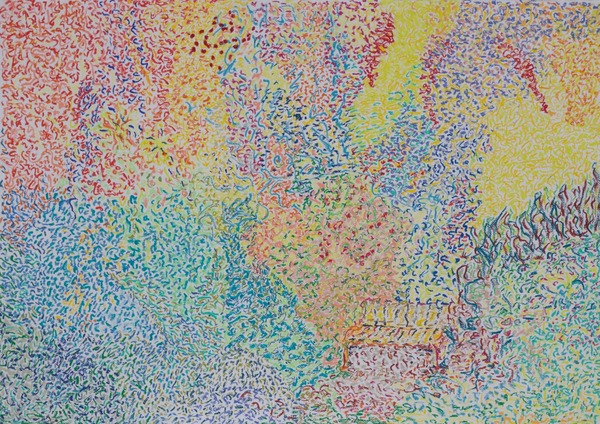Luísa
Costa Gomes
A OUTRA COISA
“A
pintura para mim é uma espécie de número de corda bamba; fica entre a
representação e a outra coisa, o que quer que ela seja; é difícil manter o
equilíbrio”.
Ian Fairweather, entrevista a Hazel de
Berg,1965
Entre
uma coisa e a outra coisa, entre a náusea do excesso e o horror ao vazio,
pintar é brincar com a figura e o seu desfigurar, com o gesto que forma e
deforma, combatendo na medida do útil e necessário, a harmonia pré-estabelecida
da forma e do fundo, a sua hierarquia fisiológica, do Isto no Aquilo. É ver
como esse Coelho a si mesmo contrário, as orelhas apontando em reflexão
retrospectiva e olhando, perplexo, talvez temeroso, esse Adunde, o Para Onde da
representação. Penso em Asger Yorn a pintar o interior do Arquivo da Revolução
na Havana, ou no seu jardim da Ligúria, numa vertigem de inscrever tudo em
tudo, de fazer tudo de tudo e com tudo. Entediado pela conferência sobre a
conversão cultural para que tinha sido convidado, Yorn meteu-se a pintar murais,
sem esquecer as escadas, à volta de janelas, debaixo do corrimão, até a colunas
da sala. Penso nessa compulsão para pintar em tudo e habitar a pintura, libertando-se
enfim da galeria, da grilheta da moldura e da maldição do passepartú. Mas a
casa contém pinturas cujo destino é transbordarem pelo jardim. Esse não é o
jardim de dentro para fora de Bonnard, com as suas traves e esquadrias que
amparem o olho, esse é o viver na selva. Penso em Ian Fairweather, o anacoreta
do bush australiano, pintando em papel de jornal quando não havia mais
onde aplicar a mão. A obra por vezes não sobrevivia à viagem até Londres,
chegando, consumada a sua fragilidade, em forma de papier mâché. A
influência de Fairweather veio muito après la lettre: conheci a sua
pintura depois de ter feito essas cabeças-paisagens estilizadas, cujos sulcos
são estradas num mapa e vincos de expressão. A porosidade das cabeças faz delas
cabeças no ar. Mas enquanto não detecta a figura, o olho inquieta-se. Busca, fareja
e, no jardim, compõe caramanchões e das manchas faz magnólias, bancos à espera
de mulheres que neles se reclinem, encontra banheiras sem baigneuses,
camas sem dormeuses, clareiras sem danseuses. Provavelmente
estarão, mas obnubiladas pela luz, escondidas bem à vista, nessa memória abismada
em Bonnard. E penso em Bonnard como espectadora das suas luzes, numa homenagem
o seu tanto gauche e carnavalesca. Será possível agir sobre o papel sem
reconhecer a história dessa mesma acção? Será possível ver sem construir o
contexto da visão?
“Painting to me is
something of a tightrope act; it is between representation and the other thing
– whatever that is. It is difficult to keep one’s balance.”
Ian Fairweather, interview a Hazel de Berg, 1965
Between one thing and The Other Thing, between the nausea of excess and the horror of the void, painting is playing with facing and defacing, and mostly deliberately misrepresenting, in the gesture that forms and deforms - fighting against the pre-established harmony of ground and background, of the This in That, of their physiological hierarchy. Think of that Rabbit to itself contrary, its ears pointing in retrospective reflexion, looking, puzzled, maybe a little fearful, at the Adunde, the Whereto of Representation. I think of Asger Yorn painting the interior of the Revolution Archive in Havana or in his Ligurian garden, and in creation as vertigo of inscription of everything on everything, of making everything out of everything and with everything. Bored with the conference about cultural conversion to which he had been invited in the sixties, Yorn started painting murals, on the walls, on the stairs, on the staircase, around the windows, even around the column in the conference room. I think about that compulsion and in painting as habitat, freeing it from the constraints of the gallery, the weight of the frame and the curse of the passepartout. In its primitive memory painting yearns for the cave and for the garden. But not the Bonnardian garden that is seen from inside the living room, through windows and stairs and other frames that guide and support the eye. It is living in the jungle per se. I think about Ian Fairweather, the hermit of the Australian bush, painting on newspaper, when he didn´t have anything else that he could lay his hands on. Sometimes the work did not survive transportation, arriving at the gallery in the consummated fragile form of papier mâché. I met Fairweather's paintings only recently, three years after I painted those heads/landscapes, with its furrows that are roads on maps and expression wrinkles. The porosity of the heads makes them lightheaded and connected. As long as it does not detect a figure, the eye is restless. It searches and noses it out in the garden, it composes arbors and from blots and lines makes out magnolias, benches awaiting reclining women, and there it finds bathtubs without baigneuses, beds without dormeuses, clearings without danseuses. They are probably there but obnubilated by light, hidden in plain sight, in the abysmal memory of Bonnard. And, yes, I think of Bonnard, as spectator of his lights, in a reference maybe gauche and carnival like. Is it possible, do you think, to act over paper without recognising the history of that same action? Is it possible to build a vision, without building its context?
Luísa Costa Gomes










